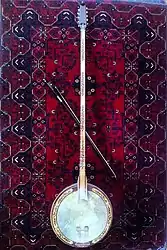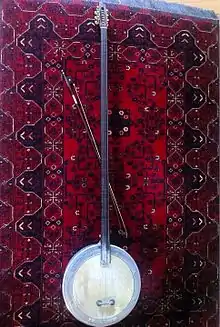 | |
| Classification | |
|---|---|
The yaylı tambur[1] is a bowed long-neck lute from Turkey.[2] Derived from the older plucked mızraplı tambur variant of the Turkish tambur, it has a long, fretted neck and a round metal or wooden soundbox which is often covered on the front with a skin or acrylic head similar to that of a banjo.
The instrument is held vertically, with the soundbox resting in the player's lap or between the calves. The bow is grasped sideways, with the little, ring and middle fingers pressing on the horsehairs, while the thumb and index fingers hold the rightmost wooden edge of the bow. The leftmost strings of the instrument unite into a single course to form a doubled-string which is tuned to a unison that is lifted slightly from the bridge. This is where all melodic playing takes place. The rest are sympathetic strings numbering from 4 to 6 which are tuned to the octave, fifth and/or fourth of the main doubled-string.
Due to the special nature of the instrument, the neck behaves as though it was unfretted despite the ordinary placement of numerous frets (anywhere from 24 to 34 or more to the octave). That is to say, the fingers can press down on unfretted parts of the neck to achieve the same effect as stopping the frets. This allows the glissandi and portamenti to be executed flawlessly which constitute the primary characteristics of the yaylı tambur. Moreover, the frets can be moved about depending on the tastes and choices of the player to achieve correct intonation of a given makam.
Dr. Ozan Yarman has proposed an alternate 24-tone tuning and fretting for the tambur that he has applied to his own instrument, which replaces the Arel-Ezgi-Uzdilek tone-system in use for Turkish Art music while also relying on the same array of accustomed microtonal accidentals to notate.[3]
_positions_and_traditional_names_according_to_author's_Yarman-24_tuning.jpg.webp)
See also
References
- ↑ "Türk Dil Kurumu - Sözlük". sozluk.gov.tr.
- ↑ Martin Stokes (1 October 2010). The Republic of Love: Cultural Intimacy in Turkish Popular Music. University of Chicago Press. pp. 170–. ISBN 978-0-226-77506-7. Retrieved 9 June 2012.
- ↑ Ozan Yarman (25 April 2010). Arel-Ezgi-Uzdilek Sistemine Alternatif, 24-Sesli, Islah Edilmiş Ortaton Temperamanı Temelli Ve Basit Oranlı Bir Düzen (PDF). ARTES Yayınları. pp. 64–99. ISBN 978-605-5664-05-3. Retrieved 4 January 2013.
External links
![]() Media related to Yaylı tambur at Wikimedia Commons
Media related to Yaylı tambur at Wikimedia Commons
